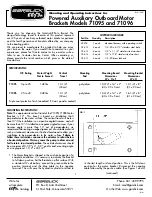
Technical Summary For USB-ML-12E Rev. C
The pin-out of the connector as specified by Freescale is:
2
Usage Of The USB BDM MULTILINK Interface
The USB BDM MULTILINK can communicate with an RS08, HCS08, HC12, HCS12 or ColdFire V1 processor.
P&E’s software packages will automatically detect the proper communication rate to establish a connection with
the target. For HC12/HCS12 devices, the BDM communication speed may be set (instead of being auto-detected)
by setting the value of the IO_DELAY_CNT variable. The proper IO_DELAY_CNT may be calculated by the
equation:
IO_DELAY_CNT = (120000000 / Fbus) – 1
where Fbus is the bus frequency in hertz.
Note:
RS08 and HCS08 frequencies are always detected automatically.
The Multilink interface will work with targets whose processor power supply is in the range of 1.6V to 5.25V. The
Multilink interface derives its power from the USB port and as such draws less than 1mA from the target.
The USB BDM MULTILINK has a female type B USB connector. Use a Type A to Type B USB extension cable to
connect the interface to the PC.
The USB BDM MULTILINK is a USB device. If a USB Hub is used, it must be a self-powered hub (i.e. with its own
power supply). By default, the USB protocol used is 2.0.
There are two LEDs which protrude through the housing of the USB BDM MULTILINK interface. The Blue LED
indicates that the Multilink interface is powered and running. The Yellow LED indicates that target power has been
detected.
The 6-pin ribbon cable, which allows connection to the target debug connector, is fixed within the Multilink housing.
PIN 1 is denoted by the red stripe running down the ribbon cable.
3
Driver Installation On Windows XP/2000/2003/Vista/7
Before connecting the USB BDM MULTILINK to the PC, the appropriate drivers need to be installed on the PC. The
drivers are automatically installed when installing any of P&E’s recent RS08/HCS08/HC12/HCS12 development
packages. Windows 7 users who are installing software distributed before December 28, 2009 will need to obtain
the latest version of the drivers. A copy of the driver installation program may be downloaded from the “Downloads”
section of P&E’s “Support Center” located at http://www.pemicro.com. If you are using third-party software, make
sure you have a version which supports the USB BDM MULTILINK Rev. C interface.
When the cable is plugged in, the operating system should indicate that it has found a driver for the attached “USB
Multilink 2.0”. Follow the instructions in the “Found New Hardware Wizard” dialog for having Windows
automatically install the driver.
If you connected the Multilink interface prior to installing the drivers, Windows will not have been able to find the
appropriate driver and may have disabled the device. If you unplug the device and then plug it in again, Windows
will automatically disable it even if you have installed the drivers. To force Windows to attempt to load the driver
again, perform the following steps while the USB BDM MULTILINK interface is plugged into the computer:
1.
Open the Control Panel: Start Button [ ->Settings ] ->Control Panel. (You will not need to select “Settings” on
Vista and Windows 7).
2.
Double Click the “System” Icon. (Windows 7: “System and Security”)
3.
Select the “Hardware” Tab. (Windows 7: “Hardware and Sound”, Windows Vista: skip this step)






















